
Index 값 기준으로 정렬하기
-
구성 :
sort_index(행 or 열 방향, 오름 or 내림차순) -
axis = 0 : 행 인덱스 기준 정렬(Default: 오름차순)
df = df.sort_index(axis = 0)
원본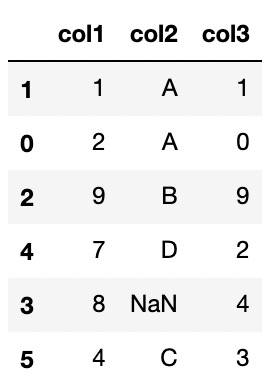
결과값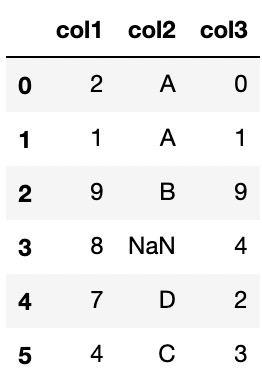
-
axis = 1 : 열 인덱스 기준 내림차순 정렬
df.sort_index(axis = 1, ascending = False)
원본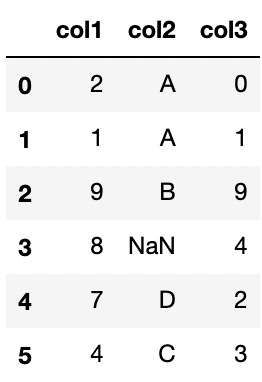
결과값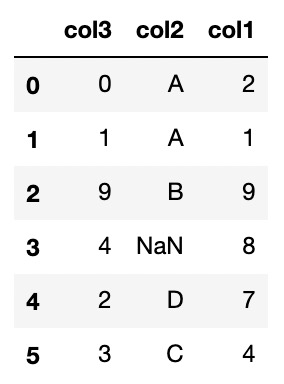
Column 값 기준으로 정렬하기
-
구성 :
sort_values(컬럼 이름, 오름 or 내림차순) -
col1 컬럼 기준 정렬(Default 오름차순)
df.sort_values('col1', ascending = True)
원본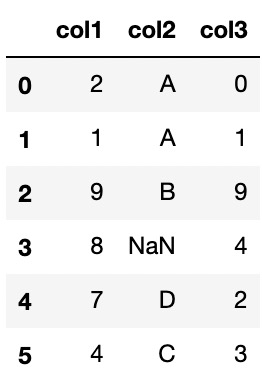
결과값
-
col1 컬럼 기준 내림차순 정렬
df.sort_values('col1', ascending = False)
원본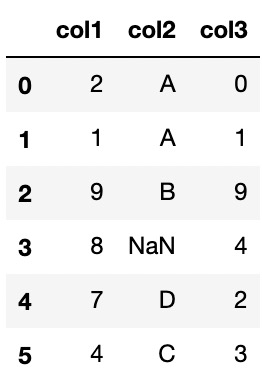
결과값
-
col2 컬럼 기준 오름차순 정렬 후 col1 컬럼 기준 내림차순 정렬
df.sort_value(['col2','col1'], ascending = [True, False])
원본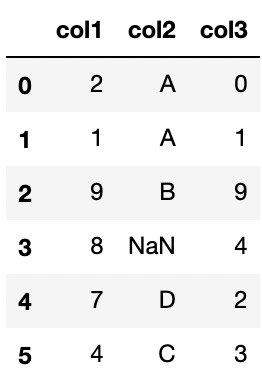
중간 과정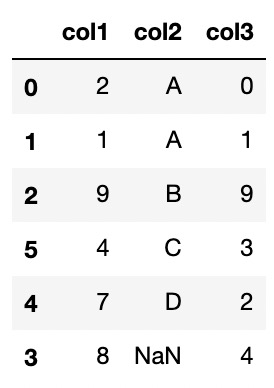
결과값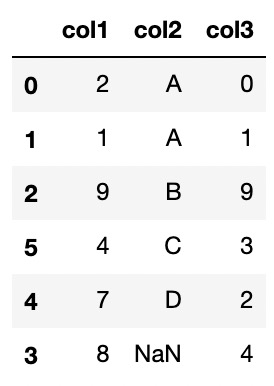
결과값에서 col2 오름차순 정렬을 방해하지 않고 col1 내림차순 정렬을 하게 됨.
즉, col1 오름차순 정렬을 하게 되면 co2 A 값 내에서 co1 1, 2 순으로 정렬됨.
[실습 1] 데이터프레임 정렬하기
문제
데이터 프레임에 입력되어 있는 값을 오름차순, 내림차순으로 정렬해 봅시다.
- 데이터 프레임을
col1을 기준으로 오름차순 정렬한 결과를sorted_df1에 저장하고 출력해주세요.- 데이터 프레임을
col2를 기준으로 내림차순 정렬한 결과를sorted_df2에 저장하고 출력해주세요.- 데이터 프레임을
col2를 기준으로 오름차순 정렬한 뒤,col1을 기준으로 내림차순정렬한 결과를 출력해봅시다. 즉, 2개의 정렬 기준을 두어야 합니다. 정렬한 결과를sorted_df3에 저장하고 출력해주세요.import numpy as np import pandas as pd print("DataFrame: ") df = pd.DataFrame({ 'col1' : [2, 1, 9, 8, 7, 4], 'col2' : ['A', 'A', 'B', np.nan, 'D', 'C'], 'col3': [0, 1, 9, 4, 2, 3], }) print(df, "\n")code
# 정렬 코드 입력해보기 # 1. col1을 기준으로 오름차순으로 정렬하기. sorted_df1 = df.sort_values('col1', ascending = True) print(sorted_df1)
2. col2를 기준으로 내림차순으로 정렬하기.
sorted_df2 = df.sort_values('col2', ascending = False)
print(sorted_df2)
3. col2를 기준으로 오름차순으로, col1를 기준으로 내림차순으로 정렬하기.
sorted_df3 = df.sort_values(['col2','col1'], ascending = [True, False])
print(sorted_df3)
## 실행 결과DataFrame:
col1 col2 col3
0 2 A 0
1 1 A 1
2 9 B 9
3 8 NaN 4
4 7 D 2
5 4 C 3
col1 col2 col3
1 1 A 1
0 2 A 0
5 4 C 3
4 7 D 2
3 8 NaN 4
2 9 B 9
col1 col2 col3
4 7 D 2
5 4 C 3
2 9 B 9
0 2 A 0
1 1 A 1
3 8 NaN 4
col1 col2 col3
0 2 A 0
1 1 A 1
2 9 B 9
5 4 C 3
4 7 D 2
3 8 NaN 4
